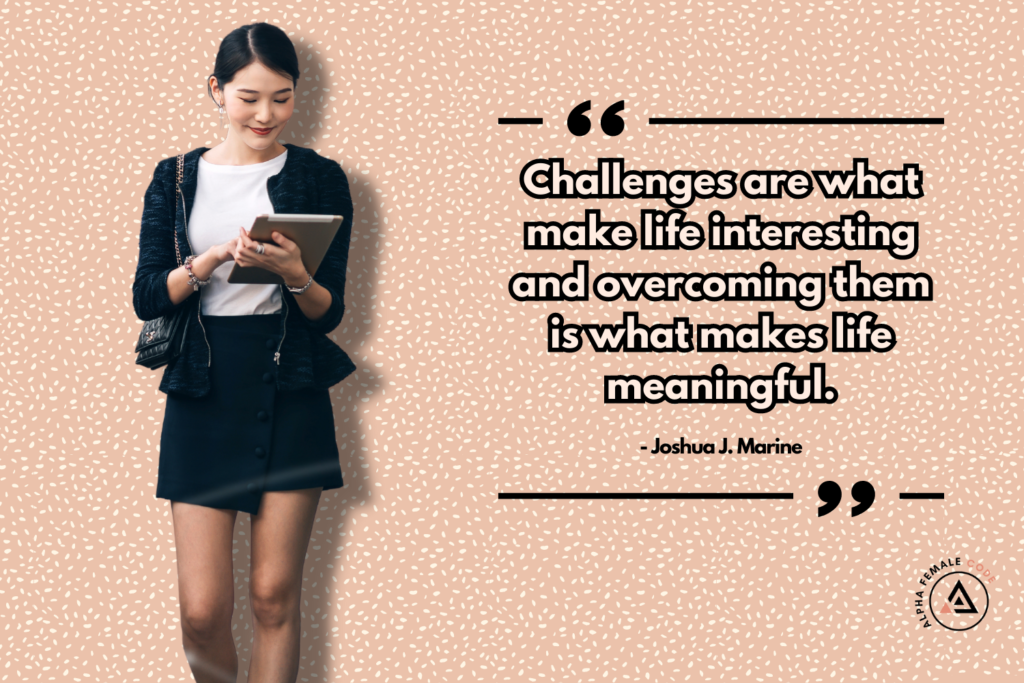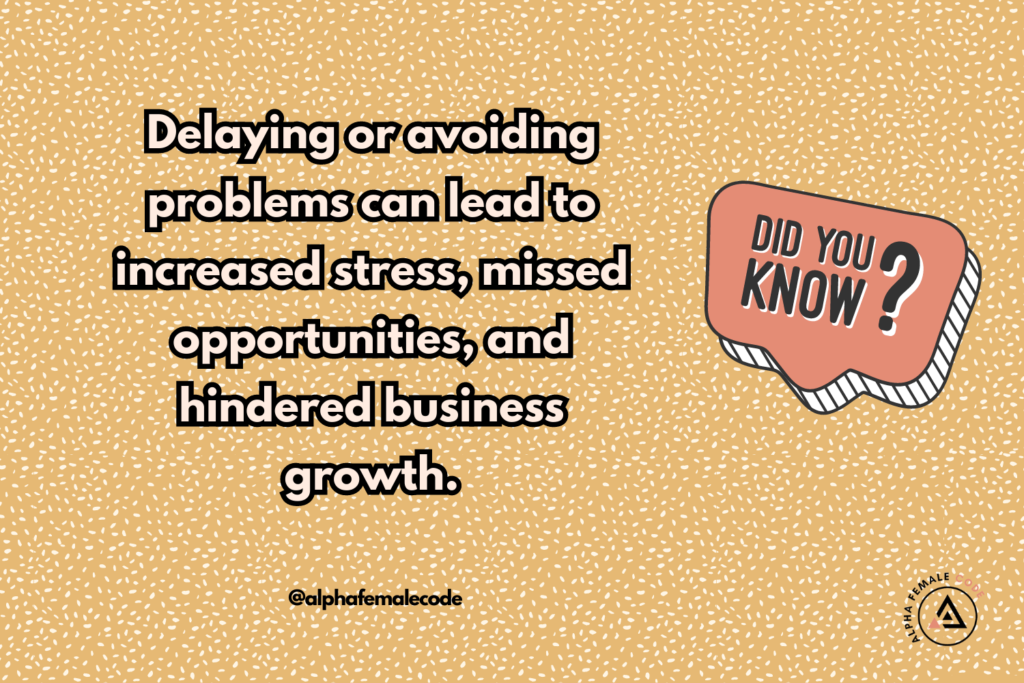
Building a successful service-based business requires more than just a stellar product or service. It demands a mindset that allows you to navigate challenges with grace, resilience, and unwavering determination. Welcome to our ultimate guide on “How to focus on the solution, not the problem.”
While acknowledging the existence of challenges is essential, our primary focus should be on finding creative solutions to overcome them.
Let’s dive right in and discover the secrets to unlocking your success by shifting your focus from problems to solutions.
Disclaimer: This site contains affiliate links to products. We may receive a commission for purchases made through these links. Visit my disclaimer page for more information.

How to focus on the solution not the problem?
#1 Embrace self-awareness.
Be aware of your thoughts, emotions, and reactions to the problem. This self-awareness allows you to approach the problem with a clear and focused mindset. Here’s exactly how to use self-awareness to help you along.
- 🌟 Spotlight Your Strengths: Identify your unique strengths and leverage them to tackle the problem head-on. Whether you’re a multitasking guru, a networking pro, or a creative genius, let those strengths shine as your secret weapons for success.
- 🌟 Reflect in the Mirror: Remind yourself that you’re capable, confident, and ready to take on any challenge that comes your way. You’re a force to be reckoned with!
- 🌟 Crush Limiting Beliefs: Challenge those sneaky limiting beliefs that try to hold you back. Replace “I can’t” with “I can and I will.” Believe in your abilities, trust your instincts, and let go of anything that limits your potential.
#2 Leave emotion outside the door.
By leaving emotions outside the door, you open up space for clear thinking, practical solutions, and a more focused problem-solving mindset.
While emotions are natural, try to set them aside when analyzing the problem. Emotions can cloud judgment and hinder your ability to find practical solutions.
- 💭 Set Intentions for Emotional Detachment: Before diving into problem analysis, set clear intentions to leave your emotions at the door. Remind yourself that an emotion-free mindset will lead to clearer thinking and more effective problem-solving. Take a deep breath and mentally release any emotional baggage.
- 💭 Engage in Rational Thinking: Activate your rational thinking superpowers! Use logic and reason to assess the problem objectively. Ask critical questions, evaluate different angles, and consider alternative viewpoints. Keep your thoughts grounded in practicality and effectiveness.
RELATED POSTS:
Why you should take a step back to move forward to success.
What to do when nothing seems to work?
How positive attitude leads to success?
Journaling for entrepreneurs – tips to get the most out of it.
How to get out of your own way and stop sabotaging yourself.
#3 Release the stress quickly.
When it comes to focusing on solutions, we can’t overlook the importance of releasing stress quickly.
Picture this: You’re facing a daunting business challenge, and stress is creeping in. It’s natural to feel overwhelmed, but releasing stress quickly is the secret ingredient to unlocking your problem-solving prowess! Here’s why:
- you create mental space for clear thinking and laser-focused problem-solving.
- you regain your mental balance, allowing logic to reign supreme.
- you’ll make sound decisions based on facts and analysis, rather than succumbing to impulsive or emotionally-driven choices.
Need some stress release strategies that will help you conquer problems with ease, here they are:
- Sweat it Out with Exercise 💦: Get your endorphins pumping, release tension, and boost your mood.
- Find Peace with Meditation and Mindfulness 🧘♀️: Allow yourself to recharge and gain mental clarity for effective problem-solving.
- Engage in Creative Outlets 🎨: Immersing yourself in a creative activity helps release stress and promotes a sense of joy.
- Unplug and Disconnect 📵: Disconnecting allows you to recharge, recharge, and foster meaningful connections.

#4 Reframe the problem.
Reframing allows you to shift your mindset from viewing problems as insurmountable roadblocks to seeing them as opportunities for growth and innovation. Instead of being overwhelmed by negativity, you embrace a “can-do” attitude that fuels motivation, perseverance, and a belief in your ability to overcome any obstacle.
How to reframe the problem:
💡 Ask Powerful Questions: Engage in reflective questioning to explore the problem from various angles. Ask yourself questions like “What can I learn from this challenge?” or “How might this problem be an opportunity in disguise?” These questions prompt you to think beyond the surface and uncover hidden opportunities.
💡 Reframe with Positive Language: Use positive and empowering language to reframe the problem. Instead of saying, “I can’t do this,” reframe it as “I’m learning and growing through this experience.” This simple shift in language can change your perspective and open up new possibilities.
#5 Discuss with your support group.
When it comes to focusing on solutions, don’t underestimate the power of a supportive network.
Others may offer different viewpoints, share their experiences, or suggest solutions you might not have considered. It broadens your horizons and expands the pool of possibilities.
They will provide emotional support, encouragement, and a safe space to share your thoughts and concerns. Their understanding and empathy help you navigate difficulties with resilience.
How to make the most of discussions with your support group:
- Build a Supportive Network: Surround yourself with like-minded individuals who share your entrepreneurial journey. Seek out mentors, colleagues, fellow entrepreneurs, or industry-specific communities that can provide valuable insights and support.
- Define Your Problem Clearly: Before discussing with your support group, clearly define the problem you’re facing. Outline the key aspects, challenges, and desired outcomes. This clarity will help guide the conversation and ensure everyone understands the issue at hand.
- Seek Varied Perspectives: Encourage open dialogue and invite different perspectives from your support group. Embrace diversity of thought, backgrounds, and experiences. Create an environment that encourages everyone to share their insights freely and respectfully.
- Active Listening and Constructive Feedback: Practice active listening during discussions, giving each person the opportunity to express their thoughts. Offer constructive feedback and ask clarifying questions to deepen the conversation. Respectfully challenge ideas to stimulate critical thinking and exploration of alternative solutions.

#6 Understand the problem inside out.
By understanding the problem inside out, you go beyond surface-level symptoms and uncover the underlying root causes.
It allows you to address the core issues rather than merely treating the symptoms, leading to more effective and long-lasting solutions.
When you have a deep understanding of the problem, you can make well-informed decisions based on solid evidence and insights. It minimizes guesswork, reduces the risk of making hasty judgments, and increases the likelihood of choosing the most suitable solution.
How to understand the problem inside out:
- 🔍 Begin by collecting as much information as possible about the problem. The more information you have, the better equipped you’ll be to analyze the problem.
- 🕵️♀️ Break the problem down into its key components and analyze each element individually. This step helps you gain a holistic view of the problem and identify the most critical areas to address.
- 🎯 Apply the “Five Whys” technique by repeatedly asking “Why?” to uncover the underlying causes of the problem. Keep digging deeper with each “Why?” until you reach the root cause.
#7 Visualise your ideal outcome.
Visualization allows you to crystalize your goals and aspirations. By visualizing your ideal outcome, you gain clarity about what you truly want to achieve.
It becomes a vivid representation of your dreams, guiding your actions and motivating you to work towards them.
Visualization also programs your subconscious mind. By repeatedly picturing your ideal outcome, you program your subconscious to align your thoughts, beliefs, and actions with your desired results. It creates a powerful mental framework that supports your journey towards success.
How to visualize your ideal outcome:
- 🎯 Create a Clear Mental Image: Close your eyes, take a deep breath, and create a vivid mental picture of your ideal outcome. Imagine every detail: the sights, sounds, and emotions associated with achieving your goals. Make it as real and vibrant as possible in your mind.
- 📝 Write it Down: Put your vision into words by writing it down in a journal or vision board. Describe your ideal outcome in detail, using descriptive language that ignites your passion. Use positive affirmations and empowering statements to reinforce your belief in the possibility of achieving your goals.
- 🎥 Visualize Daily: Set aside dedicated time each day to visualize your ideal outcome. Make it a ritual and prioritize it in your schedule. It could be in the morning before starting your day or in the evening before winding down. Consistency is key to reinforcing your vision and strengthening your focus on solutions.

#8 Don’t delay or avoid the problem.
Procrastination only allows problems to grow and become more daunting. By not delaying or avoiding the problem, you seize the opportunity to address it at the earliest. This proactive approach prevents issues from escalating and grants you more time to find effective solutions. Here are some tips:
- 📅 Set a Deadline: Establish a clear deadline for addressing the problem. Assigning a specific timeline creates a sense of urgency and ensures that you take action promptly.
- 🗓️ Prioritize the Problem: Give the problem the attention it deserves by placing it high on your priority list. Avoid getting overwhelmed by other tasks or distractions.
- 💥 Break it Down: Break the problem down into manageable parts. Sometimes, a problem may seem overwhelming as a whole, but breaking it into smaller, actionable steps makes it more approachable.
- 🚀 Take Imperfect Action: Don’t wait for the perfect solution or all the answers before taking action. Embrace the concept of “progress over perfection” and take the first step, even if it’s imperfect.
#9 Make a list of everything you can control.
When facing a problem, it’s easy to get caught up in things beyond your control. Creating a control list helps you shift your focus to what you can change.
It directs your energy towards actionable steps and allows you to make progress, rather than feeling stuck or overwhelmed by external factors.
Making a control list empowers you to take ownership of your circumstances. It reminds you that you have the power to influence outcomes and make a difference.
Here are some tips to help you gain back some control:
- 📝 Brainstorm and Reflect: Take a moment to brainstorm and reflect on the problem at hand. What aspects of the situation are within your control? Write down all the factors that you believe you can influence, change, or take action on.
- 🕵️♀️ Assess Your Sphere of Influence: Analyze the problem from different angles and consider the areas where you have the most influence. Identify the specific elements that fall within your sphere of control.
- ✅ Prioritize and Take Action: Once you have your control list, prioritize the items based on their impact and feasibility. Start with the actions that have the greatest potential to lead you towards the solution.
- 🚧 Accept the Uncontrollable: While focusing on what you can control is vital, it’s equally important to accept the things you can’t change. Some factors will lie outside your influence, and that’s okay.

#10 Start working towards the solution.
Taking action transforms your ideas into tangible results. It bridges the gap between envisioning the solution and actually making it happen.
By initiating the process, you move from a passive state of contemplation to an active state of creation.
Sometimes, we get caught in a cycle of overthinking and analyzing every aspect of the problem. Taking action breaks this cycle!
How to start working towards the solution:
- 🎯 Define Your First Step: Identify the crucial first step that will set the ball rolling. Break down the solution into manageable components and pinpoint the initial action that will have the most significant impact.
- 💪 Embrace a Bias for Action: Adopt a mindset of “taking action now” rather than waiting for the perfect moment or all the answers.
- 📝 Create a Action Plan: Outline a clear action plan that maps out the steps you need to take. Identify the tasks, allocate resources, and set realistic deadlines. Break the plan into actionable milestones that will serve as markers of your progress.
- ⏰ Time Management: Schedule dedicated time in your daily routine for working towards the solution. Protect this time as sacred and commit to it.
#11 Reassess the solution and do more of what works.
Reassessing the solution allows you to evaluate its effectiveness and identify areas for improvement. By acknowledging what works, you can build upon those successful elements and refine your approach.
When you focus on the strategies and actions that yield positive results, you optimize your time, energy, and resources.
Here are some quick-fire tips to help you along.
- 📊 Analyze Results: Evaluate the outcomes of your current solution.
- ✅ Double Down on Success: Once you’ve identified what works, double down on those strategies and actions.
- 🔄 Adapt and Experiment: While focusing on what works, remain open to adaptation and experimentation.
- 📈 Set Measurable Goals: Define specific, measurable goals to track your progress. Establish metrics that align with your desired outcomes.
#12 Use an alternative solution if not achieving the required results.
Exploring alternative solutions introduces fresh perspectives and ideas into your problem-solving process. It encourages you to think outside the box and consider innovative approaches that you may not have initially considered. This openness to new possibilities can lead to breakthroughs and unexpected success.
When your current solution isn’t achieving the desired results, using an alternative approach allows you to maximize opportunities.
How to use an alternative solution if not achieving the required results:
- 💡 Generate New Ideas: Brainstorm and generate alternative ideas or solutions to address the challenges you’re facing.
- 🔀 Pivot or Adapt: Once you’ve explored alternative solutions, be willing to pivot or adapt your approach.
- 📊 Monitor and Measure: Implement the alternative solution and closely monitor its impact.
#13 Learn from it for the future.
Reflect, extract key lessons, and apply feedback to improve.
- 📚 Reflect on Experiences: Take time to reflect on your experiences, both successes, and setbacks. Consider the actions you took, the outcomes you achieved, and the lessons embedded within each experience. Ask yourself what worked well, what didn’t, and what you would do differently next time.
- 🌱 Extract Key Lessons: Identify the key lessons learned from each experience. Look for patterns, themes, and insights that emerge.
On a final note…
Remember, the road to achieving your goals will have its twists and turns, but armed with a solution-oriented mindset, you have the resilience and adaptability to overcome any obstacle that comes your way.
